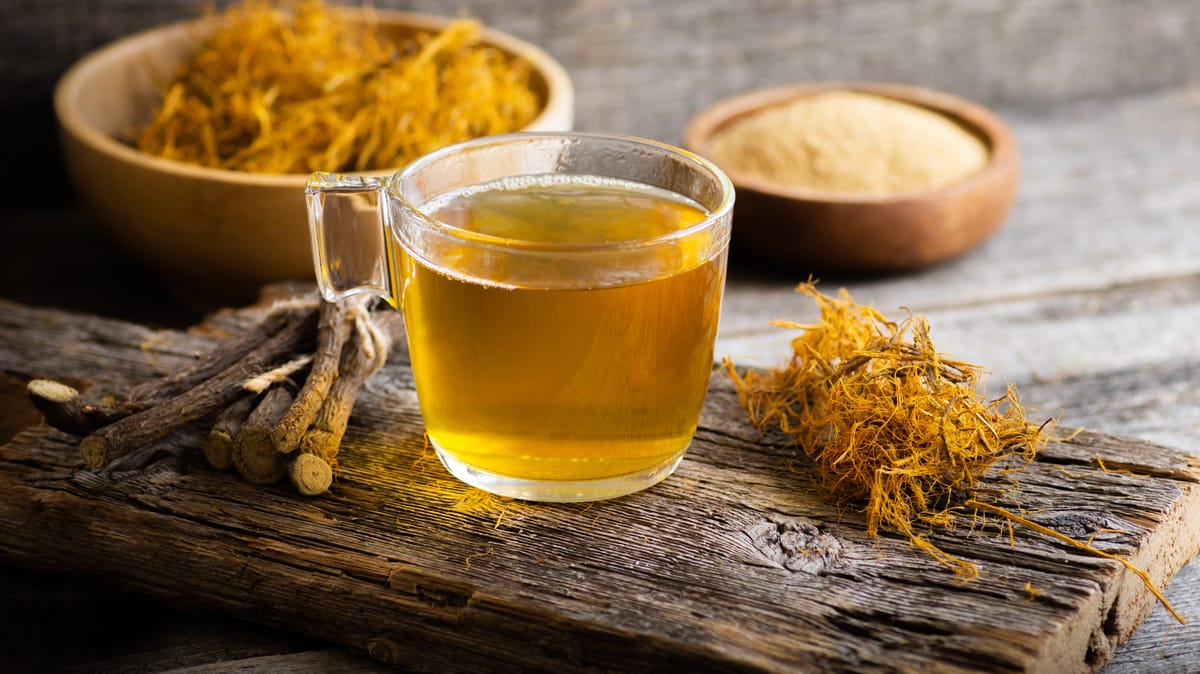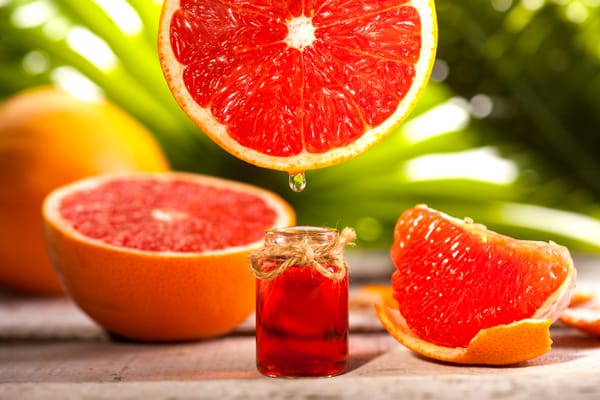Licorice Root Tea: Sweet Sip with Surprising Benefits
Discover the unique flavor and potential health perks of licorice root tea. Learn how to brew and enjoy this herbal delight safely.

If you're tired of the same old tea routine, boy do I have a treat for you! Let me introduce you to the sweet, slightly quirky world of licorice root tea. This isn't your grandma's bland herbal brew, oh no. Licorice root tea is like the cool, leather-jacket-wearing cousin at the tea party. It's got a distinct flavor that might catch you off guard at first, but trust me, it grows on you faster than you can say "glycyrrhizin." (That's the compound that gives licorice its signature sweetness, by the way. Bonus points if you can pronounce it!)
But licorice root tea isn't just a pretty taste. This herbal wonder has been used for centuries in traditional medicine for a whole host of reasons. From soothing sore throats to supporting digestion, licorice root tea is like the Swiss Army knife of herbal remedies. So, ready to dive into the sweet, surprising world of licorice root tea? Let's go!
What Is Licorice Root Tea?
Licorice root tea. It's an herbal tea that's been around for centuries, steeped in history and flavor. But what exactly is this intriguing brew?
Ready to embark on a flavorful adventure? Licorice root tea is more than just a tasty beverage – it's a journey through history, health, and pure enjoyment.
Overview of Licorice Root
First things first, let's talk about where licorice root comes from. It's derived from the root of the licorice plant, scientifically known as Glycyrrhiza glabra. This perennial herb is native to Europe and Asia, where it's been used for medicinal purposes for thousands of years.
Licorice's distinctive sweet flavor and potential health benefits come from the compounds found in its lengthy, woody roots, especially glycyrrhizin. These roots go through a process of harvesting and drying before they're ready to be turned into tea and other delightful products.
How Licorice Root Tea Is Made
So, how does a gnarly root transform into a soothing cup of tea? The process is quite simple. The dried licorice root is either cut into small pieces or ground into a powder. These loose leaf bits or powder are then steeped in hot water, typically for 5-10 minutes, to extract the flavor and beneficial compounds.
Some people prefer to use licorice root tea bags for convenience, but I personally love the ritual of brewing loose leaf tea. There's something magical about watching the water slowly infuse with the essence of the licorice root.
Flavor Profile of Licorice Root Tea
Now, let's talk taste. Licorice root tea has a distinct flavor that people either love or, well, don't love. It's often described as sweet and slightly earthy, with a hint of natural anise-like flavor. This sweetness comes from glycyrrhizin, which can be up to 50 times sweeter than sugar.
I'll admit, it took me a few cups to acquire a taste for licorice root tea. But once I did, I was hooked. It's now my go-to afternoon pick-me-up. I find the unique flavor profile to be soothing and satisfying.
Table of Contents:
- What Is Licorice Root Tea?
- Potential Benefits of Licorice Root Tea
- Precautions and Side Effects of Licorice Root Tea
- How to Prepare and Enjoy Licorice Root Tea
- Conclusion
Potential Benefits of Licorice Root Tea
Licorice root tea isn't just a tasty treat; it's also loaded with potential health perks. As someone who's felt the positive impact firsthand, I'm thrilled to share how this herbal tea might help you feel great.
Soothing Sore Throats and Upper Respiratory Issues
When your throat feels scratchy and your upper respiratory system is under the weather, reach for a comforting mug of licorice root tea. The tea's silky texture will coat your throat, offering a welcome respite from discomfort. Licorice root tea is a tried-and-true way to relieve symptoms and help you feel better faster.
I'm living proof of the power of licorice root tea. That first throat tickle or cough? Brew a potent cup of this sweet, warm liquid – stat. It's like a loving hug for your respiratory system, and it never fails to deliver much-needed relief.
Supporting Digestive Health
Licorice root tea may also support digestive health. It has been traditionally used to help relieve symptoms of acid reflux and peptic ulcers. The tea's anti-inflammatory properties can soothe the digestive tract and may even help protect the stomach lining.
Heartburn can be a real pain, but I've discovered a tasty solution: licorice root tea. Sipping on this warm, comforting beverage after meals has made a noticeable difference in keeping my symptoms at bay. Who knew that supporting gut health could be so delicious and natural?
Anti-Inflammatory Properties for Skin Health
The anti-inflammatory properties of licorice root tea may also benefit skin health. Some studies suggest that applying licorice root extract topically or consuming the tea regularly may help soothe skin conditions like eczema and dermatitis.
I've noticed that when I drink licorice root tea consistently, my skin looks clearer and more radiant. It's like the tea is working its magic from the inside out.
Other Potential Health Benefits
Imagine sipping on a warm, comforting cup of licorice root tea and knowing that you're not just enjoying a delicious beverage, but also potentially giving your body a boost in all sorts of ways. Research hints that this age-old herbal remedy might be a real multitasker – from supporting adrenal gland function and keeping hormone levels in check to providing a gentle laxative effect when needed. It's like having a secret wellness weapon in your tea cupboard.
I've discovered that sipping on licorice root tea is my secret weapon for feeling my best. This delightful brew has a way of keeping me grounded and energized, no matter what life throws my way. It's a non-negotiable part of my daily self-care practice.
Precautions and Side Effects of Licorice Root Tea
Licorice root tea may offer a range of potential benefits, but it's essential to approach this herbal beverage with caution. Side effects can occur, and as someone who has extensively researched this topic, I want to share some crucial points to consider before making licorice root tea a regular part of your routine.
Potential Impact on Blood Pressure and Potassium Levels
One of the main compounds in licorice root, glycyrrhizin, can cause an increase in blood pressure and a decrease in potassium levels if consumed in large amounts. This is because glycyrrhizin can cause the body to retain sodium and excrete potassium.
If you have a history of high blood pressure or heart conditions, it's crucial to talk to your healthcare provider before adding licorice root tea to your diet. They can help you determine if it's safe for you to consume and in what amounts.
Interactions with Medications
Heads up. Licorice root tea can be a bit of a troublemaker when it comes to certain medications. If you're taking blood thinners, blood pressure drugs, or diuretics, the tea might make these medications work too well or not well enough. And trust me, that's not a fun surprise.
Always inform your doctor about any herbal teas or supplements you're consuming, including licorice root tea. They can help you navigate any potential interactions and ensure that your medications are working effectively.
Tooth Decay Risk
While the sweetness of licorice root tea is one of its appealing qualities, it's important to remember that this sweetness comes from natural compounds, not added sugars. However, consuming licorice root tea frequently may still contribute to tooth decay if proper oral hygiene isn't maintained.
Licorice root tea is a delicious treat, but don't forget to brush your teeth afterwards. The natural sugars in the tea can stick to your teeth, so giving them a good scrub will keep your smile shining bright.
When to Avoid Licorice Root Tea
There are certain situations where it's best to avoid licorice root tea altogether. Pregnant women should steer clear of this herbal beverage, as the glycyrrhizin in licorice root may increase the risk of preterm labor.
Got hypertension, heart disease, kidney disease, or low potassium levels? Then licorice root tea might not be your cup of tea - literally. This brew can mess with managing these conditions or even make 'em worse. But if your healthcare professional says it's okay, then go ahead and take a sip.
How to Prepare and Enjoy Licorice Root Tea
Alright, tea lovers, now that we've gone over the potential benefits and things to keep in mind with licorice root tea, it's time for the exciting part: making and savoring this one-of-a-kind herbal drink. As someone who's a bit obsessed with tea (guilty.), I can't wait to share some of the tips and tricks I've picked up along the way.
Choosing Licorice Root Tea Forms
Licorice root tea comes in a few different forms, each with its own advantages. Loose leaf licorice root is my personal favorite, as it allows for a more customizable brewing experience. You can control the strength of the tea by adjusting the amount of root you use.
Tea bags are another convenient option, especially if you're on the go or don't want to fuss with loose leaf tea. Just make sure to choose a high-quality brand that uses pure licorice root without any artificial additives.
Brewing Instructions for Loose Leaf and Tea Bags
Brewing the perfect cup of licorice root tea is all about finding the right balance of water temperature, steeping time, and tea quantity. For loose leaf, I typically use about 1 teaspoon of dried licorice root per 8 ounces of water. I bring the water to a boil, then let it cool for a minute before pouring it over the root. Then, I let it steep for about 5-7 minutes, depending on how strong I want the flavor to be.
For tea bags, the process is even simpler. Just follow the instructions on the package, which usually involve steeping the bag in hot water for a few minutes. Some brands may recommend a specific water temperature or steeping time for optimal flavor.
Serving Suggestions and Flavor Enhancements
One of the beautiful things about licorice root tea is its versatility. You can enjoy it hot or iced, plain or with a touch of honey or lemon. I personally love sipping on a hot cup of licorice root tea on a chilly afternoon, letting the sweet, earthy flavors warm me from the inside out.
For the adventurous tea lover, licorice root tea is the perfect base for experimenting with flavors. Cinnamon, ginger, and fennel are all delightful companions to the inherent sweetness of licorice root. Mix and match these herbs and spices to concoct your own one-of-a-kind blends that suit your unique palate.
Get creative with your licorice root tea. Mix it up and use it as a base for herbal tea lattes or even cocktails. The sky's the limit, so let your imagination run wild and experiment with different flavor combinations.
Key Takeaway:
Discover the unique world of licorice root tea, from its sweet, earthy flavor to its surprising health benefits. It's easy to make and can soothe throats, support digestion, and even improve skin health. Just remember to enjoy it in moderation due to potential side effects like high blood pressure or tooth decay.
Conclusion
Well, there you have it - the lowdown on licorice root tea. We've explored its unique flavor profile, potential health benefits, and how to brew a perfect cup. But we've also taken a look at the precautions and side effects to keep in mind, because let's face it, too much of a good thing can sometimes lead to trouble.
Ready to shake up your herbal tea routine? Licorice root tea is here to save the day! Its one-of-a-kind flavor will have your taste buds doing a happy dance, while its potential health benefits will give you a reason to smile. Just remember, moderation is key, and if you have any questions, your healthcare provider is always there to help.
So go ahead, grab a mug, and savor the sweet, slightly wild world of licorice root tea. Your taste buds (and maybe even your health) will thank you.




